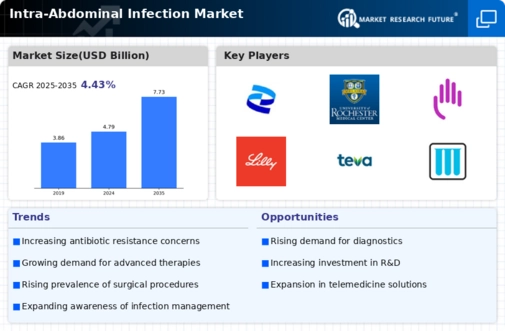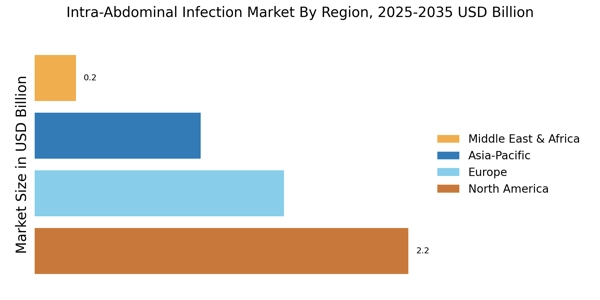Advancements in Surgical Techniques
Innovations in surgical techniques are transforming the landscape of the Intra-Abdominal Infection Market. Minimally invasive procedures, such as laparoscopic surgery, have gained traction due to their associated benefits, including reduced recovery times and lower complication rates. These advancements not only enhance patient outcomes but also drive the demand for specialized surgical instruments and technologies. As hospitals and surgical centers adopt these modern techniques, the market for intra-abdominal infection treatments is expected to expand. Furthermore, the integration of robotic-assisted surgeries may further revolutionize the field, potentially leading to increased efficiency and effectiveness in managing intra-abdominal infections.
Regulatory Support for New Treatments
Regulatory bodies are increasingly providing support for the development and approval of new treatments for intra-abdominal infections, which is positively impacting the Intra-Abdominal Infection Market. Streamlined approval processes and incentives for antibiotic development are encouraging pharmaceutical companies to invest in this area. This regulatory environment fosters innovation and expedites the availability of new therapies to the market. As a result, patients gain access to more effective treatment options, which can lead to improved health outcomes. The ongoing collaboration between regulatory agencies and industry stakeholders is likely to continue driving advancements in the Intra-Abdominal Infection Market.
Rising Incidence of Intra-Abdominal Infections
The increasing prevalence of intra-abdominal infections is a primary driver for the Intra-Abdominal Infection Market. Factors such as lifestyle changes, dietary habits, and an aging population contribute to this rise. According to recent data, the incidence of these infections has been steadily increasing, with estimates suggesting that they account for a significant percentage of hospital admissions. This trend necessitates the development of effective treatment options and diagnostic tools, thereby propelling market growth. As healthcare systems strive to manage these infections more effectively, the demand for innovative therapies and surgical interventions is likely to escalate, further stimulating the Intra-Abdominal Infection Market.
Increase in Research and Development Activities
The surge in research and development activities focused on intra-abdominal infections is a crucial driver for the Intra-Abdominal Infection Market. Pharmaceutical companies and research institutions are investing significantly in the discovery of novel antibiotics and therapeutic agents to combat resistant strains of bacteria. This focus on R&D is essential, given the rising concern over antibiotic resistance, which poses a substantial challenge in treating intra-abdominal infections. As new treatment modalities emerge from these research efforts, the market is poised for expansion. Additionally, collaborations between academia and industry are likely to accelerate the pace of innovation, further enhancing the Intra-Abdominal Infection Market.
Growing Awareness of Infection Control Practices
The heightened awareness surrounding infection control practices is significantly influencing the Intra-Abdominal Infection Market. Healthcare providers are increasingly prioritizing infection prevention strategies, which include stringent sterilization protocols and the use of advanced antimicrobial agents. This shift is driven by the recognition of the impact of hospital-acquired infections on patient morbidity and healthcare costs. As a result, there is a growing demand for products and services that enhance infection control measures. The market is likely to see an uptick in the development of innovative solutions aimed at reducing the incidence of intra-abdominal infections, thereby fostering growth within the Intra-Abdominal Infection Market.


















Leave a Comment